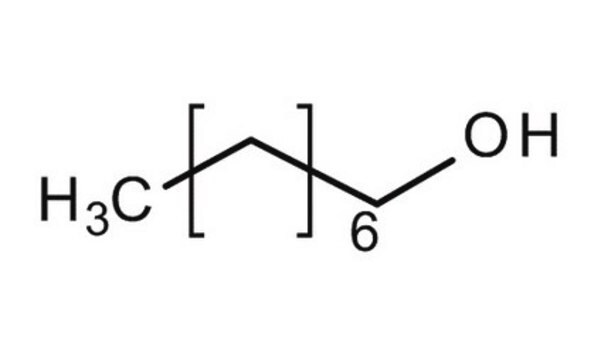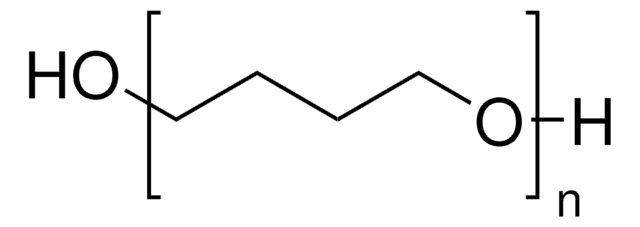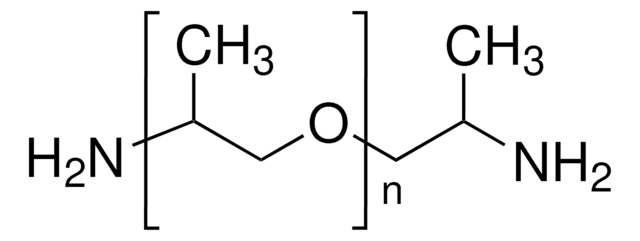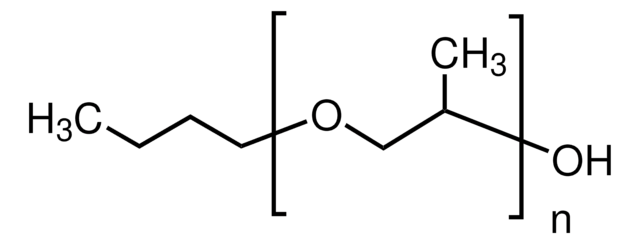202339
Poly(propylene glycol)
average Mn ~2,000
Synonym(s):
PPG, Poly(propylene oxide)
Sign Into View Organizational & Contract Pricing
All Photos(1)
About This Item
Linear Formula:
H[OCH(CH3)CH2]nOH
CAS Number:
MDL number:
UNSPSC Code:
12162002
PubChem Substance ID:
NACRES:
NA.23
Recommended Products
vapor density
>1 (vs air)
Quality Level
vapor pressure
<0.01 mmHg ( 20 °C)
mol wt
average Mn ~2,000
contains
130-190 ppm proprietary phenolic antioxidant
refractive index
n20/D 1.451
viscosity
300 cSt(25 °C)(lit.)
hydroxyl value
56 mg KOH/g
density
1.005 g/mL at 25 °C
SMILES string
CC(O)CO
InChI
1S/C6H14O3/c1-5(8)4-9-6(2)3-7/h5-8H,3-4H2,1-2H3
InChI key
DUFKCOQISQKSAV-UHFFFAOYSA-N
Looking for similar products? Visit Product Comparison Guide
General description
Poly(propylene glycol) (PPG) is a polyether. It is prepared by ring-opening polymerization of propylene oxide. PPG is less toxic and used as a dispersant in leather finishing, as a surfactant, wetting agent, and in drug formulations.
Application
Poly(propylene glycol) can be used as a:
- Corrosion inhibitor for mild steel in acid solution.
- Starting material to synthesize epoxy resin/polyurethane hybrid networks via frontal polymerization.
Storage Class Code
10 - Combustible liquids
WGK
WGK 1
Flash Point(F)
445.0 °F - closed cup
Flash Point(C)
229.44 °C - closed cup
Personal Protective Equipment
dust mask type N95 (US), Eyeshields, Gloves
Choose from one of the most recent versions:
Already Own This Product?
Find documentation for the products that you have recently purchased in the Document Library.
Customers Also Viewed
Mohammed Taghi Zafarani-Moattar et al.
Biotechnology progress, 28(1), 146-156 (2011-09-29)
In this work, we proposed a novel aqueous biphasic system (ABS) composed of polypropylene glycol P400 (PPG P400) and hydrophilic ionic liquids (IL), 1-alkyl-3-methylimidazolium bromide (alkyl = ethyl or butyl), forming an upper polymer-rich phase and a lower IL-rich phase
Celeste R Brennecka et al.
World neurosurgery, 78(5), 469-480 (2011-11-29)
Current treatments for cerebral aneurysms are far from ideal. Platinum coils are prone to compaction, and currently used liquid embolics are delivered with angiotoxic agents. This work presents initial in vivo studies of a novel liquid-to-solid gelling polymer system (PPODA-QT)
John Texter et al.
Macromolecular rapid communications, 33(1), 69-74 (2011-12-03)
The controlled atom transfer radical polymerization of an ionic liquid, 1-(11-acryloylundecyl)-3-methyl imidazolium bromide (ILBr), from both ends of a telechelic poly(propylene oxide) (PPO) macroinitiator, end-functionalized with bromoisobutyryloyl is reported. The resulting highly water-soluble triblock, poly(ILBr-b-PO-b-ILBr) is multistimuli responsive. This new
Flávia Chiva Carvalho et al.
Journal of biomedical nanotechnology, 8(2), 280-289 (2012-04-21)
In the last few decades, nanotechnology has led to an advance in the development of topical drug delivery. Nanostructured drug delivery systems enable the compartmentalization of drugs in restricted environments, modifying the release profile and maintaining the required drug concentration
R De Lisi et al.
Physical chemistry chemical physics : PCCP, 13(27), 12571-12577 (2011-06-15)
The study highlighted the main forces driving the formation of hydroxypropyl-cyclodextrins (HP-CDs) + poly(propylene) glycol 725 g mol(-1) inclusion complexes. The temperature parameter was chosen as the variable to modulate the hydrophobicity of the polymer, and consequently ITC experiments as
Our team of scientists has experience in all areas of research including Life Science, Material Science, Chemical Synthesis, Chromatography, Analytical and many others.
Contact Technical Service








